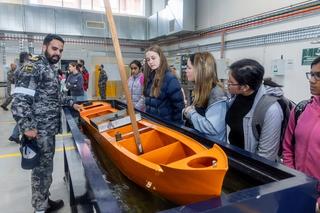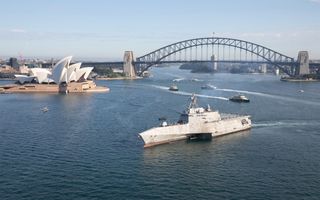In Q3 2024, the United States Studies Centre partnered with the McKell Institute to host a Track 1.5 policy workshop at NSW Parliament House to discuss and progress the participation of New South Wales in the AUKUS Pillar 1 nuclear-powered submarine enterprise. More than 30 senior representatives from the state government, trade unions, industry, education and research sectors convened for a closed-door discussion of the opportunities and impediments facing the industrial uplift, workforce development and social license for AUKUS in New South Wales. The following report outlines key insights and recommendations arising from this dialogue of stakeholders critical to the AUKUS enterprise.
Executive summary
- The AUKUS submarine project has been presented by senior officials in the Australian Government as a “whole-of-nation” opportunity. However, the extent and form of New South Wales’ contribution to the AUKUS enterprise remains unclear. Despite officials’ rhetorical commitment to a national enterprise, the focus of announced opportunities has overwhelmingly been on Western Australia and South Australia. This is problematic when the success of the AUKUS partnership will depend on contributions from all states, including from Australia’s largest state economy — New South Wales.
- AUKUS implementation efforts stand to benefit from New South Wales’ large and skilled labour force, competitive defence industry, substantial tertiary education sector and nationally unique nuclear-aware workforce. Home to 40% of the Australia’s defence and aerospace industry and nearly a third of its total manufacturing income, New South Wales is the nation’s cornerstone for nuclear expertise.
- At present, the combination of limited engagement and understanding around AUKUS among NSW stakeholders and structural barriers has impeded NSW’s participation in the AUKUS submarine enterprise. The absence of a state-level industrial plan for the enterprise, lack of clear demand signals and barriers to entry into the AUKUS supply chain are among the greatest challenges identified by industry representatives.
- Though the NSW Government is taking steps to address future workforce shortages, the lack of coherence among announced federal and state-level workforce initiatives and continued shortfalls in STEM education are seen as considerable impediments.
- Finally, mixed support expressed in opinion polling and periodic high-profile pushback against AUKUS from some NSW former political leaders, officials and union stakeholders are a sign that social license barriers persist that will affect the participation of NSW workers and organisations.

Recommendations
Over three sessions of dialogue, attendees were encouraged to provide a menu of options for NSW Government in the near to medium term to underscore its relevance and constructively contribute to Australian AUKUS efforts. Consistently cited suggestions are summarised below:
1. Industry and supply chain:
- Earn the trust of both interstate and global AUKUS partners commensurate with a federated supply chain and provide best practice models of industry uplift to model NSW’s preparedness for contribution to the AUKUS project.
- Publish a comprehensive and updatable industry plan for AUKUS at the state level to enhance market certainty around the enterprise, supplementing the NSW Defence and Industry Strategy.
- Enhance the environment for industry investment SME participation by providing clear demand signals and assuring continuity of demand where possible.
- Coordinate and expand NSW stakeholder advocacy at the federal and international levels for industrial opportunities.
- Reform Defence NSW and separate it from Invest NSW to best surface and regularise engagement opportunities for prospective participants in the AUKUS enterprise and grow the cohort responsible for stewarding NSW engagement in AUKUS.
2. Workforce and training:
- Establish New South Wales as a recruitment, skills and training hub for the AUKUS Enterprise.
- Plan for and promote an AUKUS-specific talent pipeline of skilled workers in New South Wales that encourages entry at both the early-career and mid-career levels.
- Expand nuclear-specialised degrees and mainstream nuclear awareness across tertiary education, leveraging NSW’s competitive advantage in nuclear education.
- Leverage skilled migration to increase workforce availability in and adjacent to AUKUS priority areas by updating the NSW skills list, prioritising relevant workers in NSW application screening and coordinating with other states in shaping federal migration policy, among other efforts.
3. NSW stakeholders’ attitudes towards the AUKUS project:
- Consider developing a shared understanding and measurements of “success” across AUKUS stakeholders at federal and state levels.
- Strengthen NSW stakeholder outreach and coordinate advocacy around AUKUS to enhance local buy-in.
- Release a statement of support from the state government to signal NSW commitment to the AUKUS enterprise.
- Appoint a dedicated NSW State Minister for Defence Industry, similar to the existing positions in Queensland, West Australian and South Australian Parliament.
Introduction
Australia’s acquisition of nuclear-powered, conventionally armed submarines (SSNs) now sits at the centre of Australia’s defence strategy. Australia’s economic wellbeing, security and identity have long been defined by the country’s maritime domain. Some 99% of Australia’s international trade by volume transits through the country’s ports and 97% of its data traffic is sustained by 15 known undersea cables.1 Accordingly, securing a transformative maritime capability leap through AUKUS is considered of utmost importance by Australian senior officials and defence force personnel.2
Equally, AUKUS will be the largest and most complex procurement in Australian defence history. Accordingly, national officials have been direct that AUKUS can only succeed through a whole-of-nation effort. In a joint address, Prime Minister Albanese and Minister for Defence Richard Marles noted that AUKUS represents a “whole-of-nation opportunity for new jobs; new industries, and new expertise in science, technology, and cyber.”3 Australia’s leaders have committed that “businesses right across the country in every state and territory will have the opportunity to contribute to and benefit from these opportunities over decades.”4
Yet, more than three years into the project, stakeholders across Australia are still waiting for their chance for input to materialise. South Australia and Western Australia are the nucleus of activity for AUKUS initiatives as the states manufacturing Australia’s future fleet of nuclear-powered submarines and Australia’s hub for SSN operations, maintenance and sustainment, respectively. As such, it is understandable that resources and attention are presently concentrated in these two states while the enterprise gets underway. However, AUKUS cannot succeed off the back of two states alone. Concentrating both investment and policy focus in this manner forgoes a crucial opportunity to draw on the expertise located in other Australian states and earn both the confidence and support of the broader national public. Most importantly the AUKUS endeavour will not succeed without the industrial capacity of Australia’s more densely populated areas.
To achieve sovereign supply chains, recruit an effective workforce at scale and maintain nationwide political support for the project, the Australian Government cannot afford to neglect New South Wales in their plans for AUKUS implementation.
This is especially true of Australia’s most populous state and largest state economy: New South Wales. Yet, at present, apart from likely hosting a future East Coast submarine base, the role for New South Wales in delivering AUKUS remains almost entirely opaque.5 New South Wales’ role could make a significant contribution to the delivery of the submarine project. NSW workers and training facilities bring the requisite skills base and scale to help ensure the endeavour succeeds. New South Wales accounts for around a third of national economic output. Its ports alone are estimated to support A$127 billion of Australia’s annual international trade value.6 It is home to the largest labour force in Australia and a considerable industrial ecosystem, employing more defence industry skilled workers than any other Australian state, with over 65,000 people working directly or indirectly in the sector.7
To achieve sovereign supply chains, recruit an effective workforce at scale and maintain nationwide political support for the project, the Australian Government cannot afford to neglect New South Wales in their plans for AUKUS implementation. Nor can the NSW Government afford not to be proactive in seizing the opportunities that lay before it. A failure by NSW stakeholders to creatively imagine their state’s inputs and advocate at the national level forgoes industrial and economic opportunities for their population and may lead to a poorer outcome for this critical undertaking of Australian national security. The following report is an effort to surface perceived opportunities and challenges facing NSW participation in the AUKUS endeavour. It advances an agenda for both the state and federal governments to tap into the state’s nuclear expertise, manufacturing capability and community of workers to translate the ambitions of the AUKUS submarine program into reality.
1. Industry and supply chain
1.1 State of play
Though AUKUS was formed as a trilateral agreement between officials, it will be manifested as an industry-to-industry partnership as the three countries’ submarine industrial bases seek to integrate and complement one another. Dialogue participants noted that Australia’s AUKUS enterprise will require an estimated 2,000 suppliers, demanding a significant national industry uplift. Australia’s success will depend upon a national approach to industry planning to ensure this base is effective, resilient and sovereign. NSW defence industry is well-positioned to contribute to this supply chain. New South Wales is home to 40% of the country’s defence and aerospace industry, 29% of aircraft manufacturing and repair services exports and over 80 defence facilities.8 While employment in the defence industry is growing nationwide, the Australian Bureau of Statistics (ABS) finds the largest increases are in New South Wales.9 As of 2019, Sydney’s dynamic business and entrepreneurial environment saw it ranked second among cities in the Asia-Pacific for innovation.10 Taken together, the state’s industry is well-placed for the AUKUS effort.
While employment in the defence industry is growing nationwide, the Australian Bureau of Statistics finds the largest increases are in New South Wales.
1.2 Opportunities
The submarine industrial bases of both the United States and the United Kingdom are currently overextended and struggling to meet national requirements due to delays, cost overruns and labour shortages.11 Though this presents a long-term challenge for the success of AUKUS writ large — namely, Australia’s purchase of two to three Virginia-class submarines from the US Navy — it creates an opportunity for Australian suppliers in the near-term. Australia stands to become a critical node in a global industrial uplift for manufacturing nuclear-powered submarines and related capabilities. Australian shipbuilder Austal has started building modules for Virginia-class submarines at its shipyard in Alabama. Specifically, its capacity to effectively maintain and sustain rotationally deployed US and UK submarines may open doors for Australia to input into the carrier program and other related initiatives.
NSW industry stakeholders in attendance were enthusiastic about defence industrial capability in the state. The NSW defence industry’s core competencies in advanced manufacturing, sustainment, project management and cybersecurity are frequently highlighted in state government documents and provide a competitive advantage nationally.12 Industry representatives observed opportunities for their organisations in an integrated AUKUS supply chain. Already, a NSW steel manufacturer has been authorised to produce steel at its Port Kembla facility for Newport News Shipbuilding, a division of HII, one of two US companies that designs and builds US nuclear-powered submarines.13 These pilot arrangements provide a model for participation in a future federated AUKUS supply chain.
Providing New South Wales a greater role within the shipbuilding supply chain will offer the AUKUS enterprise an important management strategy — at once increasing political buy-in, diversifying the supplier base and creating more resilient supply chains. This can alleviate unforeseen geopolitical and environmental risk offering greater flexibility and creating viable alternative routes to meet demand. This diversification and increased business engagement may also bring the added benefit of driving competitive prices and optimising production processes. It enables the enterprise to draw on the particular expertise residing among NSW stakeholders, and also ensures that AUKUS becomes truly ‘whole-of-nation’, with opportunities for workers across Australia, rather than concentrated in a few areas.
At home, there are perceived opportunities for New South Wales across each phase of the AUKUS submarine pathway. Participants observed that, though much of the supply chain for the Collins-class life of type extension is already determined, opportunities may arise for New South Wales firms to input. More importantly, with Australia’s SSN-AUKUS build strategy yet to be developed, New South Wales’ competitive industries stand to feature across the supply chain. Attendees cited niche advantages in advanced manufacturing, robotics and computing in New South Wales as key areas that could be leveraged behind the AUKUS project. The extent of their contribution will depend upon the Australian Government’s awareness of, and interest in, a nationally distributed set of industry partners, and NSW industry’s preparedness to seize opportunities.14 Stakeholders noted existing government initiatives to this end, such as the development of the Advanced Manufacturing Research Facility (AMRF), which aims to assist NSW manufacturers to scale up production and offers access to technology and training networks.15 Attendees encouraged government and university leadership to negotiate for NSW universities to host the development of a nuclear propulsion laboratory.
1.3 Impediments
Though there is a breadth of opportunity, NSW industry stakeholders report sweeping impediments to participating in both national and trilateral industrial uplift. Firstly, while supply chain integration with the United States and the United Kingdom is a logical and optimal path forward, political and cost barriers hamper this effort. As all AUKUS partners seek supply chain sovereignty, Australia needs to establish itself as a reliable, trusted and effective partner contributing to critical inputs, rather than merely delivering secondary functions. To this end, participants expected that Australia’s greatest task at hand may be grappling with the combined challenges of its perceived comparatively higher labour costs,16 and its AUKUS partners’ long-standing preference for domestic suppliers. In the absence of these inputs, Australia may struggle to build the economies of scale required for Australian industry to operate in this space.
Participants expected that Australia’s greatest task at hand may be grappling with the combined challenges of its perceived comparatively higher labour costs, and its AUKUS partners’ long-standing preference for domestic suppliers.
These barriers to entry are especially pronounced for small to medium enterprises (SMEs). Industry attendees voiced their doubts about the capacity of SMEs to navigate long lead times for government contracts and to comply with government standards. With little investment capacity for the significant one-off costs of non-recurring engineering required to commence operations, SMEs will struggle to demonstrate capability and be accepted as Tier II suppliers beyond the direct submarine industrial workforce. Stakeholders noted the Australian Government’s reluctance to work directly with Tier III and IV suppliers. Taken together, these trends inhibit NSW industry from participating in AUKUS. Overcoming official reticence and growing awareness in Australia and among AUKUS partners is compounded by its lack of exposure to international partners, with trilateral officials’ visits and attention concentrated in Western Australia and South Australia. Shortage of engagement is a disincentive for NSW SMEs’ participation.
NSW firms noted they require political support to uplift, particularly in providing clear demand signals. State governments in South Australia and Western Australia, confident in their role in AUKUS delivery, have taken measures that are illustrative; South Australia, for instance, established an Office for AUKUS to provide a single point-of-contact to state stakeholders and struck corporate partnerships to facilitate supply chain uplift in the state.17 In contrast, NSW industry stakeholders repeated that their official outreach around AUKUS is intermittent, plagued with uncertainty and suffers from ‘investment riddles’. Lingering scepticism about continuity of work and uncertainty around the viability of the business environment undermine the business case for participating in this project for NSW stakeholders. Playing in AUKUS will undoubtedly be costly for businesses in the early phase, as they expand certain practices and bid for work. The risk of major layoffs due to financial constraints and cashflow issues if industrial development is abortive will temper business enthusiasm to pursue opportunities in the AUKUS enterprise.
State government engagement and advocacy with the Department of Defence and the Australian Submarine Agency, specifically, is seen as essential to carving out pathways for NSW industry contribution. In addition, industry is interested in greater clarity from officials when it comes to tapping into existing schemes including the National Reconstruction Fund to support business uplift and capital investment. The $A15 billion National Reconstruction Fund includes defence capability as one of seven priority areas to increase financial flows, diversify and transform Australia’s industry and economy through debt finance, equity finance and guarantees.18
A lack of public communication and few official investment decisions in New South Wales around this enterprise convey little in the way of opportunities for NSW stakeholders. This was corroborated by remarks from a major industry group representative, who reported a decline in defence members in New South Wales despite a rise in national membership, due to perceived shortages of opportunities within the state. Participants noted a contradiction between the Australian Government’s urging for rapid defence industrial uplift nationwide and yet simultaneously cautioning of businesses about relying exclusively on Defence-funded opportunities and encouraging SMEs to develop dual-use technology. In response, stakeholders called upon both federal and state governments to provide tangible guarantees and reassurances that engagement in the AUKUS enterprise would lead to continuity of work.
1.4 Recommendations
Earn the trust of both interstate and global AUKUS partners commensurate with a federated supply chain and provide best practice models of NSW industrial uplift on related projects to model NSW’s preparedness to contribute to the AUKUS project.
The Australian Government must make determined efforts to earn trust and qualify Australian businesses to contribute to AUKUS partners’ industries. These efforts have national benefits, as a near-term deliverable of AUKUS, an economic opportunity, a means of upskilling workers and a demonstration of value to Australia’s partners. The government’s approach to sustainment, including the appointment of a “Sovereign Sustainment Partner”, may serve as a guide for other AUKUS areas.19 The selection of long-term industry partners assures a coordinated and concerted approach to the enterprise at a national level and facilitates outreach at an international level. To put NSW corporations on the front foot to embrace these opportunities, the state government must demonstrate by example NSW capability and seek to engage the wider AUKUS ecosystem, including international suppliers. Work currently underway in New South Wales needs to be understood by the Australian Government to best plan for the state’s contribution to the whole-of-nation effort.
Publish a comprehensive and updatable industry plan for AUKUS at the state level to enhance market certainty around the enterprise, supplementing the NSW Defence and Industry Strategy.
Federal and state government action is needed to foster the confidence required for industry to assume risk and to pursue investments in AUKUS capabilities. Though defence industry, universities and unions are eager to embrace AUKUS overall, current market signalling efforts are yet to provide the certainty or adequate incentives required to spur significant investment. Stakeholders called upon the NSW Government to release a regional industrial plan committing to continuous onshore production in the state. This approach will spur a collective understanding of strategic priorities, including associated milestones and expected benchmarks in the short, medium and long terms. Stakeholders noted this should be informed by consultation with unions, capitalising on their global networks to build relationships across workforces and strengthen synergies across AUKUS partners. In the near-term, this could be trialled as a dedicated subcomponent of the broader NSW Defence and Industry Strategy.
Enhance the environment for industry investment SME participation by providing clear demand signals and assuring continuity of demand where possible.
Recognising the disproportionate barriers to SMEs participation in the AUKUS enterprise, the NSW Government should prioritise SME engagement in its industrial plan (as per previous recommendation) to nurture a conducive business environment for industry. Noting the expansive start-up ecosystem in New South Wales, this will be especially important in this state. Such an approach would include acknowledging that certain concessions may be necessary and assuring appropriate market certainty, resources and flexibility to enable industry actors to confidently make trade-offs (e.g. compromising efficiency to maximise worker engagement and continuity of work).
If New South Wales intends to seize upon AUKUS-related opportunities, it needs to better engage with its peers at national and international levels and promote New South Wales as a capable and effective manufacturing centre.
Coordinate and expand NSW stakeholder advocacy at the federal and international levels for industrial opportunities.
If New South Wales intends to seize upon AUKUS-related opportunities, it needs to better engage with its peers at national and international levels and promote New South Wales as a capable and effective manufacturing centre. NSW stakeholders should build a coherent, shared understanding of their value proposition through regular intra-state outreach, leveraging nuclear experience, manufacturing expertise and recent investments in emerging technological capabilities, to advocate for New South Wales contributions to national AUKUS work. Subsequently, NSW officials, industry groups and unions can coordinate their engagement with federal and international decision-makers in the AUKUS enterprise.
Reform Defence NSW and separate it from Invest NSW to best surface and regularise engagement opportunities for prospective participants in the AUKUS enterprise and grow the cohort responsible for stewarding NSW engagement in AUKUS.
While some stakeholders remarked upon their positive relationships within Defence NSW, others observed some challenges with its operations. Defence NSW being buried within Investment NSW, unlike the model of other Australian states where the state defence body operates independently and publicly, presents a challenge for industry. An independent, well-resourced, agency led by a senior public servant is required. This organisation must be focused on well-publicised, regularised outreach to make pathways for engagement clearer to NSW stakeholders. Appointing an NSW Defence Advocate (a position that has been inert, if not entirely vacant, since January 2023) and tasking them with seeking opportunities and overseeing inputs into the AUKUS will be a key component of better positioning Defence NSW for this enterprise.
2. Workforce and training
2.1 State of play
The Australian Government estimates that the acquisition of SSNs will create and require 20,000 jobs over the next 30 years across government, defence and industry.20 This need for the optimal pathway has underscored the challenges facing workforce development at both national and state levels. After a period of near-record low unemployment, Australia is currently experiencing economy-wide labour shortages. In the manufacturing sector, it is projected that 120,000 additional workers will be required by 2033 to meet national demands.21 The combined effect of skills scarcity and an ageing workforce make this a somewhat tenuous proposition.
To achieve critical mass, the AUKUS workforce will have to draw heavily from New South Wales. In 2022, New South Wales accounted for 30% of the country’s total manufacturing income and NSW-based manufacturers were estimated to employ 30% of Australia’s manufacturing labour.22 In its 2018 advanced manufacturing industry development strategy, the NSW Government further acknowledged current transformations characterising the manufacturing sector and committed to shifting towards advanced manufacturing, focused on delivering “high-value and high-skill services”.23 The state is home to more than a quarter of Australia’s military and defence civilian personnel and its defence industry leads national gross value-added (GVA) metrics across manufacturing, construction and professional services.24
To address projected shortages, the NSW Government has unrolled various initiatives to expand and upskill its workforce. The NSW Government, with funding support from the Australian Government, announced the establishment of TAFE NSW Manufacturing Centres of Excellence in Sydney, the Hunter and Illawarra, providing subsidised training opportunities to strengthen, among other objectives, onshore advanced manufacturing capabilities in various sectors, including defence.25 Challenges posed by the critical shortage of workers are exacerbated by notable gaps in the availability and training of current and projected workers in Science, Technology, Engineering, and Mathematics (STEM) fields. In response, the state government is providing funding and spearheading efforts to address plummeting STEM participation rates. This includes the STEM Industry School Partnerships program which has insofar benefited 200,000 students and nearly 30,000 teachers as well as unrolled a Virtual STEM Academy for students Years 5-10.26 These efforts to address labour shortages have been well received by industry and unions, though more work stands to be done to achieve the scale and sustainability required.
2.2 Opportunities
The challenges of recruiting workers around AUKUS sites, accentuated by the competing demands of concurrent projects in Western Australia and South Australia, are an opportunity for NSW workers to make invaluable input. New South Wales boasts more qualified engineers than any other Australian state. NSW is also home to the largest labour force nationwide.27 This could be leveraged to outsource certain manufacturing areas, minimising recruitment challenges for workers reluctant to relocate away from Australia’s east coast. In the United States, the outsourcing of the Virginia-class submarine manufacturing to densely populated manufacturing regions is illustrative of opportunities for New South Wales to capitalise on the availability of skilled workers to outsource and optimise certain manufacturing areas.28 The US Navy is looking to move at least 5 million production hours a year in heavy manufacturing to areas away from the major US shipyards. Using this model, New South Wales could leverage its strength in advanced manufacturing to take responsibility for certain submarine components.
NSW tertiary institutions’ academic and technical programs will prove uniquely valuable for the AUKUS enterprise. Government investment in a pipeline of STEM graduates for AUKUS has already translated into a real sense of opportunity for universities. The government committed A$128.5 million in funding to support 4,001 Commonwealth-supported places (CSPs) across Australia, over 25% of which was awarded to NSW universities.29 As the only university in Australia to offer a degree in nuclear engineering and graduating more engineers than any other Australian university (some 40% of all engineers across the state and 15% across the country, according to a workshop participant), the University of New South Wales (UNSW) is set to play an especially significant role in contributing workers to the AUKUS enterprise.30

New South Wales is the only Australian state with a bedrock of nuclear expertise. New South Wales is home to the statutory body of the Australian Government for nuclear research and production of radioisotopes for nuclear medicine, the Australian Nuclear Science and Technology Organisation (ANSTO). This confers to New South Wales a distinct competitive advantage to tap into existing technical know-how for nuclear research and innovation, as well as into a skilled workforce to respond, when relevant, to AUKUS demands for increased interchangeability across partners’ workforces at national and international levels.
A final advantage is the proficiency demonstrated by some NSW stakeholders at cross-sector collaboration, which will be essential for AUKUS workforce development and training efforts. The NSW Digital Skills and Workforce Compact, for instance, is illustrative of a multi-stakeholder approach to address evolving needs in the digital landscape and to mitigate the projected shortage of 85,000 digital workers by 2030.31 Stakeholders noted the importance of recent memoranda of understanding struck between major industry defence players and unions as further examples of efforts to build an integrative stakeholder system. Coordination currently taking place between industry, unions, universities and interest groups well-positions NSW stakeholders to participate in a necessarily integrated AUKUS training pipeline.
2.3 Impediments
Despite the Federal Government’s clear determination to address labour shortages, stakeholders noted a lack of strategic coherence across the myriad of initiatives advanced by the Australian Government. Even taken together with state-level efforts, existing initiatives are not believed to represent a sustainable skills pipeline. Dialogue attendees again cited market uncertainty as the key factor subduing businesses’ investment in upskilling their workers for AUKUS. Industry actors pointed to the significant risk and cost associated with training and investing in their employees without adequate guarantee of the long-term viability and benefits of AUKUS. Competing priorities and modest resources have caused unions to place less emphasis on labour shortages likely to impact AUKUS. Though cross-sector collaboration is taking place, greater incentives are required to break down obtrusive silos and bridge technology and workforce development efforts.
Universities, industry players and officials shared concerns for the alarming STEM skill shortage in Australia as AUKUS will be dependent upon a STEM-qualified workforce. In New South Wales, a 2017 report revealed that, for the past 15 years, enrolments in advanced mathematics courses have been declining.32 This downward shift echoes recent national trends, with 26.7% of Year 12 students undertaking intermediate mathematics level (or below) in 2022, compared to 34.9% in 2008.33 Despite a spate of state-level initiatives targeted at driving enrolment in STEM areas and some growing interest among students in advanced technology areas like artificial intelligence, students’ readiness to study STEM remains low. According to stakeholders present, the STEM skill shortage is exacerbated by the poor completion rates of foundational mathematics and engineering courses being taught as bridging courses ahead of university. For instance, stakeholders noted while TAFE offers complimentary mathematics courses for students seeking to transition into an engineering degree at the University of Technology Sydney (UTS), few have reportedly accepted this offer or succeeded in those higher studies.
The current STEM skill shortage, and the challenges in attracting STEM students, feed into broader narratives around the lack of understanding around AUKUS-related opportunities. The defence industrial base has also struggled to highlight tangible employment opportunities and career progression in manufacturing and continues to lose talent to other more mainstream trades. Central to AUKUS will be its capacity to attract, train, and retain a nuclear-capable workforce. However, industry has been at pains to capture talent amid doubts around long-term prospects in the industry in Australia as well as widespread safety concerns.
Participants observed that the potential for New South Wales to contribute to AUKUS is somewhat undermined by the security vetting challenges associated with mobilising the state’s migrant workforce. Over 60% of qualified engineers in Australia were born overseas, and the classification requirements of AUKUS work may impede their contributions to the project’s workforce.34 This is a national challenge, but it is of particular relevance to New South Wales. Data from the Australian Bureau of Statistics (ABS) indicates that 29.3% of all permanent migrants to Australia live in the Greater Sydney area alone. International students make up a huge portion of the student body at NSW universities — with more international students studying in New South Wales than any other Australian state (38% of all international students in Australia).35
2.4 Recommendations
Establish New South Wales as a recruitment, skills and training hub for the AUKUS Enterprise.
Nowhere is New South Wales’ value to the AUKUS effort more straightforward than in its delivery of training and educational initiatives. As the state government configures the NSW contribution, university programs and training provision should be front of mind. NSW university and TAFE representatives share an interest in contributing students to this effort.
Plan for and promote an AUKUS-specific talent pipeline of skilled workers in New South Wales that encourages entry at both the early-career and mid-career levels.
Stakeholders agreed as to the importance of developing and sophisticating state and federal-level plans for a pipeline of skilled workers. First, they stressed the need for training and upskilling in AUKUS-related fields to start in high school and to continue throughout workers’ careers. During high school, this could include expanding initiatives and providing further dedicated resources to encourage students to undertake STEM study.
During tertiary education, the NSW Government should aim to build on existing efforts to further fund and promote paid apprenticeships in partnership with industry. AUKUS-related industries rely heavily on apprenticeships — known to improve retention outcomes — but they require greater market certainty to credibly and viably offer these at scale. Similarly, leveraging vocational training to facilitate entry or mid-career transitions from adjacent industries into the defence sector should be a foremost priority. The VET (Vocational Education and Training) Review provides an opportunity for the vocational sector to build greater synergies with the defence-related industries and expand its offerings to students.36 This may create new opportunities to facilitate entry and career transitions into the industrial defence industry.
The Vocational Education and Training Review provides an opportunity for the vocational sector to build greater synergies with the defence-related industries and expand its offerings to students.
Such career transitions need to be backed by improved cross-sectoral and multi-stakeholder communication and cooperation. Stronger links between vocational training institutions and universities, union consultation to inform workforce planning and training, and data-sharing between unions and industry actors on shortages are just some suggestions for the NSW Government to best address workforce shortages.
Expand nuclear-specialised degrees and mainstream nuclear awareness across tertiary education, leveraging NSW’s competitive advantage in nuclear education.
New South Wales is well-positioned to lead nuclear-awareness training for the AUKUS enterprise. NSW providers should coordinate and advance their status as a key node for national training programs geared at preparation for nuclear stewardship. NSW universities should continue to pioneer specialised nuclear engineering courses, while also weaving nuclear foundations across other technical degrees. This comprehensive approach will contribute to a more broadly educated technical community fluent in the operation and safety requirements of a nuclear-powered project. In addition to assuring the long-term success of AUKUS, such an approach will be critical to ensuring an informed public discussion around the far-reaching and nuanced implications of SSN-AUKUS in preserving Australia’s interests in the Indo-Pacific.
Leverage skilled migration to increase workforce availability in and adjacent to AUKUS priority areas by updating the NSW skills list, prioritising relevant workers in NSW application screening and coordinating with other states in shaping federal migration policy, among other efforts.
Though the Australian Government will delimit migrant workers’ involvement in the AUKUS enterprise by setting conditions for visas and security clearances, New South Wales also has a role to play. The state government should optimise both its policies and its strategic communications to encourage migrant workers’ involvement in AUKUS and, importantly, adjacent sectors. NSW should prepare to backfill industrial roles with migrant workers, as members of the Australian citizen workforce are recruited and relocated to South Australia and Western Australia for highly classified AUKUS work. New South Wales can set its own skilled migration policies to nominate international workers in AUKUS-relevant sectors and ease their navigation of the process to ensure the national workforce can cope with increased demand in manufacturing, engineering and other relevant sectors.
3. NSW stakeholders’ attitudes towards the AUKUS project
3.1 State of play
The Australian public is unusually alert to the AUKUS enterprise. Earlier this year, CT Group found that more than half of Australians are aware of the agreement, in contrast to less than a quarter of people in the United States or the United Kingdom.37 Polling data suggests that a majority of Australians are supportive of the AUKUS enterprise, with 51% of survey respondents supporting Australia’s acquisition of nuclear-powered submarines according to United States Studies Centre polling and 65% in ‘somewhat’ or ‘strongly’ in favour of AUKUS cooperation according to the Lowy Institute’s annual poll.38 Still, with 47% of Australians undecided about the impact of AUKUS for regional safety, and 19% outright opposed to AUKUS-SSN acquisition, this support is not absolute.39 There is a risk that vocal opposition from a small group will erode public support for AUKUS. As this opposition feeds underlying scepticism from Australian industry and workers due to previous poor experiences with submarine programs, this may politicise AUKUS and corrode the bipartisan support AUKUS currently enjoys at the federal and state levels.
In New South Wales, polling by the Lowy Institute suggests public support for AUKUS may be slightly stronger than the national average (though this lies within the margin of error).40 Nevertheless, New South Wales is home to high-profile opponents to AUKUS. At the political level, concerns for the pact have been raised since its first announcement by figures including former premier Bob Carr, State Labor members including the Hon. Cameron Murphy and the Hon. Anthony D’Adam — though both have been clear about their commitment to Labor unity on this issue and resolving concerns in caucus — as well as by a small number of local Labor party offices.41 Over the past two years, over 4,000 union and community members have protested the establishment of a future East Coast Base in Port Kembla.42 Though these opponents lack the broad-based support that would be necessary to undermine overall bipartisan support for AUKUS at the state level, public pushback must be taken seriously. It reflects ongoing concerns among Australians (including among potential future workers in the industry) about the AUKUS Enterprise, extending from the risks of a regional conflict to the implications of the Trump presidency to the cost. Open engagement with the community, built around evidence-based data is essential to build community understanding. While not all members of the community will be supportive of AUKUS it is essential that government, industry et al are involved in community outreach, engagement and research to avoid information vacuums being filled with misinformation.

3.2 Opportunities
Stakeholders highlighted the opportunity for better strategic communications to dispel misunderstandings and build social license for AUKUS in the long term. They noted this would require, too, a unified effort from government, industry, research and scientific communities in every state to demonstrate the potential strategic and economic benefits, including those related to Australia’s security and industrial resilience. Attendees recognised that federal officials have, in recent months, been more regular in their communications about AUKUS and achieved policy successes that demonstrate political resolve from all three AUKUS countries. This includes landmark achievements around US export control changes and workforce interchangeability.
For some stakeholders, the value of their participation in AUKUS is straightforward. Buy-in from the NSW university sector, for example, has been easy to earn. Concerns for nuclear safety are likely to be greater from other states, with comparative inexperience in co-existing with a nuclear facility and who will be home in the near term to nuclear-powered submarines. In contrast, the government has more time to build public understanding around its East Coast Submarine Base than it does for near-term initiatives like Submarine Rotational Force-West.
New South Wales-based industry bodies have a record of close dialogue with the Australian Government. In the past, close consultations between government and industry ahead of the joint strike fighter program led to the successful input of industry players across the supply chain. These secured dozens of senior executives’ investment in the progression of this project and spurred a collective commitment to generating solutions to problems. Similarly, the AUKUS enterprise requires both government and industry to have a vested interest in its success. Closer collaboration between industry players and government could cultivate greater buy-in and secure ownership from industry actors over the AUKUS enterprise and the development of the defence industrial ecosystem.
3.3 Impediments
Despite high-level support for AUKUS, the government continues to be challenged in the marketplace of ideas. Though union representatives expressed interest in embracing the opportunities AUKUS presents, support for AUKUS varies among union members in New South Wales, with many apprehensive about the actual and perceived opportunities for workers, as well as the nuclear component. Further, public support for AUKUS will necessarily be influenced by perceptions of AUKUS partners, which remains, to a large extent, out of the Australian Government’s hands.
This scepticism is compounded by the sense of uncertainty that continues to shroud AUKUS cooperation. Participants noted that much work of AUKUS is proceeding at the government-to-government level, meaning stakeholders’ awareness and understanding of developments is murky. While inter-governmental coordination is essential, it is part of the means as opposed to the end of AUKUS. Only with higher levels of industry engagement and clarity funding will AUKUS be a success. Instead, there is a view that AUKUS is not being shaped by all of its critical stakeholders. NSW stakeholders are seeking more opportunities to engage with the Australian Government than have been enjoyed to date. Participants noted that much of the defence initiatives that occur in New South Wales are classified and therefore occur outside the public realm. This creates a vacuum of information for critics and sceptics alike to highlight unmet milestones and denounce slow, or ineffective developments. This feeds public doubts about Australian capacity to deliver this partnership and the opportunities for New South Wales-based workers.
Participants noted that much of the defence initiatives that occur in New South Wales are classified and therefore occur outside the public realm. This creates a vacuum of information for critics and sceptics alike to highlight unmet milestones and denounce slow, or ineffective developments.
3.4 Recommendations
Consider developing a shared understanding and measurements of “success” across AUKUS stakeholders at federal and state levels.
A set of realistic parameters, collectively developed and agreed upon among stakeholders to define ‘success’, needs to underpin government messaging around AUKUS. Many variables will determine the success of AUKUS, from securing public support in partner countries to fostering a domestic industrial and workforce uplift in Australia to reconciling national legislation for intergovernmental technological cooperation. As the optimal pathway inevitably deviates in form or schedule, the Australian Government should consult with state officials, industry, and other key stakeholders to develop a shared understanding of success. This includes securing industry and other key stakeholders’ buy-in to collectively design accessible outputs and short-term outcomes for each state, including for New South Wales, tailored to their political, economic and industrial landscape. As AUKUS meets challenges or suffers delays, strategic engagement with stakeholders and shared ownership over short to medium outputs may disparage sceptics from leveraging inevitable missed targets to erode public support.
Strengthen NSW stakeholder outreach and coordinate advocacy around AUKUS to enhance local buy-in.
When prosecuting the case for AUKUS at a national level, senior officials need to lead the market of ideas outlining the strategic rationale for the enterprise as well as showcasing the system-wide benefits of current achievements (e.g. export control changes, workforce interchangeability, etc.). Government messaging should further underscore the wider positive implications of these milestones for Australia’s role along critical global economic and technological supply chains. This should be compounded with clear communication on existing legislation and guardrails to ensure responsible nuclear stewardship and to alleviate security and environmental risks. This rhetoric needs to be backed and reaffirmed by NSW stakeholders. While confirming national messaging around AUKUS, prosecuting the case for AUKUS at the state level needs to be attuned to respond to local concerns as well as to highlight current and emerging economic and technological opportunities for New South Wales.
Release a statement of support from the state government to signal NSW commitment to the AUKUS enterprise.
In line with the recommendation to develop an industry plan at the state level, the NSW Government could release a statement of support outlining New South Wales’ unique value proposition to contribute to the AUKUS enterprise, as well as a state-level interest and strategic approach to AUKUS across sectors. This statement of support should be embodied in bipartisan signalling legislation. In addition to mitigating risks of politicisation, this may generate increased enthusiasm across NSW industry stakeholders for capitalising on local opportunities as well as strengthen public confidence.
Appoint a dedicated NSW State Minister for Defence Industry, similar to the existing positions in Queensland, West Australian and South Australian Parliament.
Replicating the position in Federal Parliament, NSW Government should nominate a Cabinet Member to serve as Minister for Defence Industry. This official would be a national advocate for NSW stakeholders and provide a clear point of contact for industry on related matters. They could oversee the implementation of AUKUS at the state level and report back to state government, improving the literacy of state officials on AUKUS issues. Finally, this position would complement the apolitical appointment of a NSW Defence Advocate previously recommended by this report to strengthen direct consistent communications within NSW Parliament on matters related to AUKUS implementation.
Project partner










